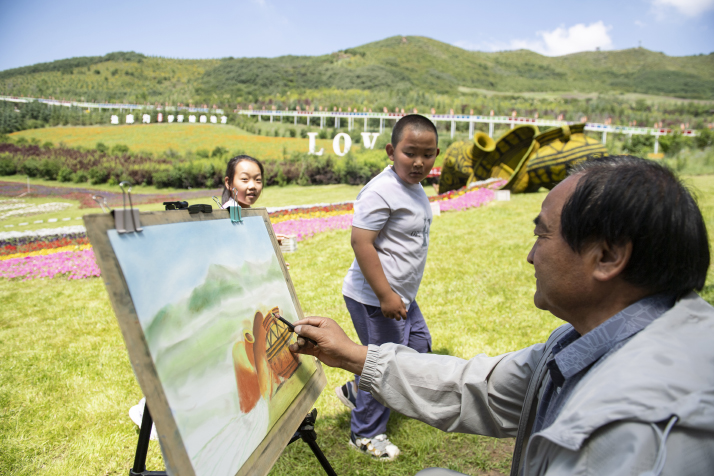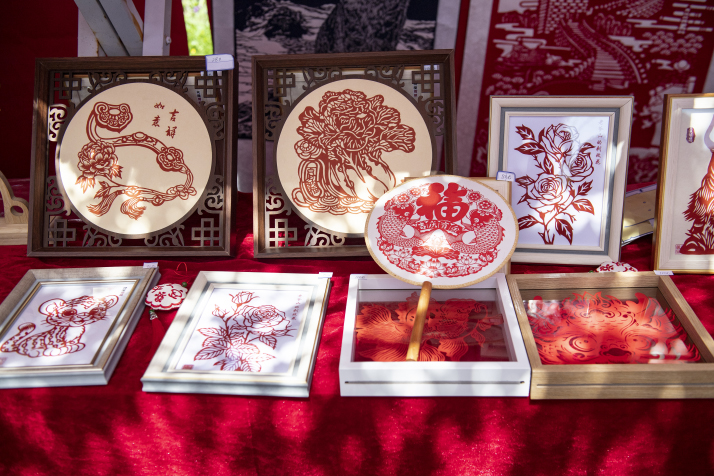| China |
| Villages develop distinctive industries to boost rural revitalization | |
|
|
 A local sketches in the Bianmagou Flower Sea Scenic Area on July 22 (XINHUA)
Stepping into the Flower Sea Scenic Area in Bianmagou Village, located in Shuobei Tibetan Township, Qinghai Province, visitors are greeted by a vibrant tapestry of blossoms: garden cosmos, verbena, lupine and more. A gentle breeze carries the fragrance of the flowers, offering a refreshing sensory experience. Bianmagou is nestled among mountains on its east, south and north. Its remote location and altitude of 2,800 meters have exposed the area to natural disasters such as heavy frosts, hail and drought, resulting in meager crop yields. "With no other sources of income available, the majority of villagers were forced to seek employment in distant cities, far from their homes," Guo Chunhui, Secretary of the Communist Party of China (CPC) Committee of Shuobei Tibetan Township, in Datong Hui and Tu Autonomous County, told reporters in a group interview on July 22.  Traditional papercut works for sale in the Bianmagou Flower Sea Scenic Area in Datong Hui and Tu Autonomous County, Qinghai Province, on July 22 (XINHUA)
Thriving tourism The transformation of the village from a poverty-stricken community to a thriving tourist destination began in 2016. It was during that year the village opened the Flower Sea Scenic Area, a project realized by pooling over 40 hectares of land from 106 households. This initiative marked the beginning of the village's rural tourism development. "Flowers are abundant everywhere, so we have been constantly challenged with creating a distinctive flower sea," Li Zhenhai, head of the Flower Sea Scenic Area, told reporters on July 22. To diversify the floral landscape, the scenic area introduced a range of exotic flower species alongside the cultivation of local varieties. Currently, the area boasts over 40 types of flowers, covering more than 40 hectares. "We also establish different floral landscape themes annually to enhance the overall tourism experience," Li added. The scenic area has also introduced recreational facilities such as cableways to enrich visitor experience. "In 2016, our village only had five homestays (where tourists stay with villagers in their homes). Now, nearly 70 out of the village's 159 households are involved in tourism," Li said. In 2024, the village's total tourism revenue reached 20 million yuan ($2.8 million) with the Flower Sea Scenic Area contributing 5.2 million yuan ($720,000). Guo said that the per-capita disposable income of the villagers surged from under 1,800 yuan ($251) in 2018 to over 21,000 yuan ($3,000) in 2024, close to the national average of rural residents in that year, which was 23,119 yuan ($3,224). The villagers of Bianmagou are accessing increasingly diversified income streams, stemming from land transfers (including rent and dividends) and the burgeoning tourism industry. Under China's land ownership system, rural land is owned by rural collectives, with the land use rights contracted to individual rural households. Land transfer here refers to the transfer of land use rights, not ownership from the villagers to the scenic area. Liu Yongmei, a 43-year-old villager, works at a shooting game facility within the scenic area. Formerly employed away from the village, she now earns 3,000 yuan ($418) monthly, allowing her to care for her child, who attends junior middle school. "I prepare breakfast for my child before work and make dinner after work. It's incredibly convenient," Liu told reporters. Another villager, Zhang Shenglian, has been employed at the scenic area for three years, also working at the shooting game stall. She works five months a year, earning approximately 20,000 yuan ($2,788). Zhang explained that her family had transferred 0.5 hectares of land to the Flower Sea Scenic Area. "The land had low productivity previously. Now, we receive thousands of yuan (hundreds of U.S. dollars) in rent and dividends from it every year," she said. Distinctive industry Beyond tourism, plateau villages in Qinghai are developing diverse industries tailored to their specific local conditions. In Guoluo Zanggunma Village, nestled within Gangcha County in Haibei Tibetan Autonomous Prefecture, rural revitalization is being driven by expanding sales channels for the village's livestock products. China's rural revitalization, a strategy introduced at the 19th CPC National Congress in 2017, promotes the economic prosperity and overall development of rural areas. It builds on the success of the nationwide poverty alleviation campaign that had eradicated absolute poverty as of late 2020. Ezang Jia, Deputy Secretary of the village's CPC branch, explained during a group interview on July 23 that herdsmen in the village used to sell their cattle and sheep live to merchants at market prices. Recognizing the need for improvement, the village established animal husbandry cooperatives to facilitate large-scale and science-based animal husbandry practices and intensive management. "The output increased, but the sales were not satisfactory," Ezang Jia noted. Overcoming the challenge by opening up new sales channels became a priority for village leaders. The leaders proactively sought out buyers beyond the village. Sonam Caidan, head of the village, recounted their travels to cities like Xining in east Qinghai and Chengdu in neighboring Sichuan Province. However, their efforts were unsuccessful, as companies in these cities did not purchase live animals or whole carcasses. "These companies prefer meat that's finely cut, packaged and even branded," Sonam Caidan explained. To better align with market demands, the village established Haibei Gangcha Gongluo Livestock Product Development Co. Ltd. last year. The company specializes in purchasing livestock from local herders and then slaughtering, processing and selling the meat. Notably, the company offers herders a premium of 2 yuan ($0.3) per kg above the prevailing market price when purchasing cattle and sheep from them. Ezang Jia, also the head of the company, explained to reporters that a yak typically weighs between 250 and 500 kg. This means that herders can earn an additional 500 to 1,000 yuan ($70-139) per yak by selling their livestock to the company, compared with previous arrangements. As of June, the company had purchased nearly 600 sheep and yaks from local herders; and it has provided jobs to eight villagers. To further expand sales channels, the company created the Gongluozang brand and has established five beef and mutton stores in Chengdu, Xining, Liaocheng in Shandong Province, Gu'an in Hebei Province, and Xianyang in Shaanxi Province. Recognizing the importance of e-commerce, the village also constructed a livestreaming base to facilitate the sale of its livestock products through livestreaming. Ezang Jia said the company has already sold over 60,000 kg of meat, generating sales exceeding 1 million yuan ($139,000). With beef and mutton sales performing strongly and reaching wider markets, the company is planning to expand its sales area further. "We are preparing to establish two additional beef and mutton stores in Lhasa, Xizang Autonomous Region, and Yushu Tibetan Autonomous Prefecture in Qinghai," Ezang Jia said. In the future, they aim to broaden the source of their livestock purchases, buying cattle and sheep from herders of other villages in Gangcha and those in other counties. (Reporting from Qinghai Province) Copyedited by G.P. Wilson Comments to jijing@cicgamericas.com |
|
||||||||||||||||||||||||||||||
|